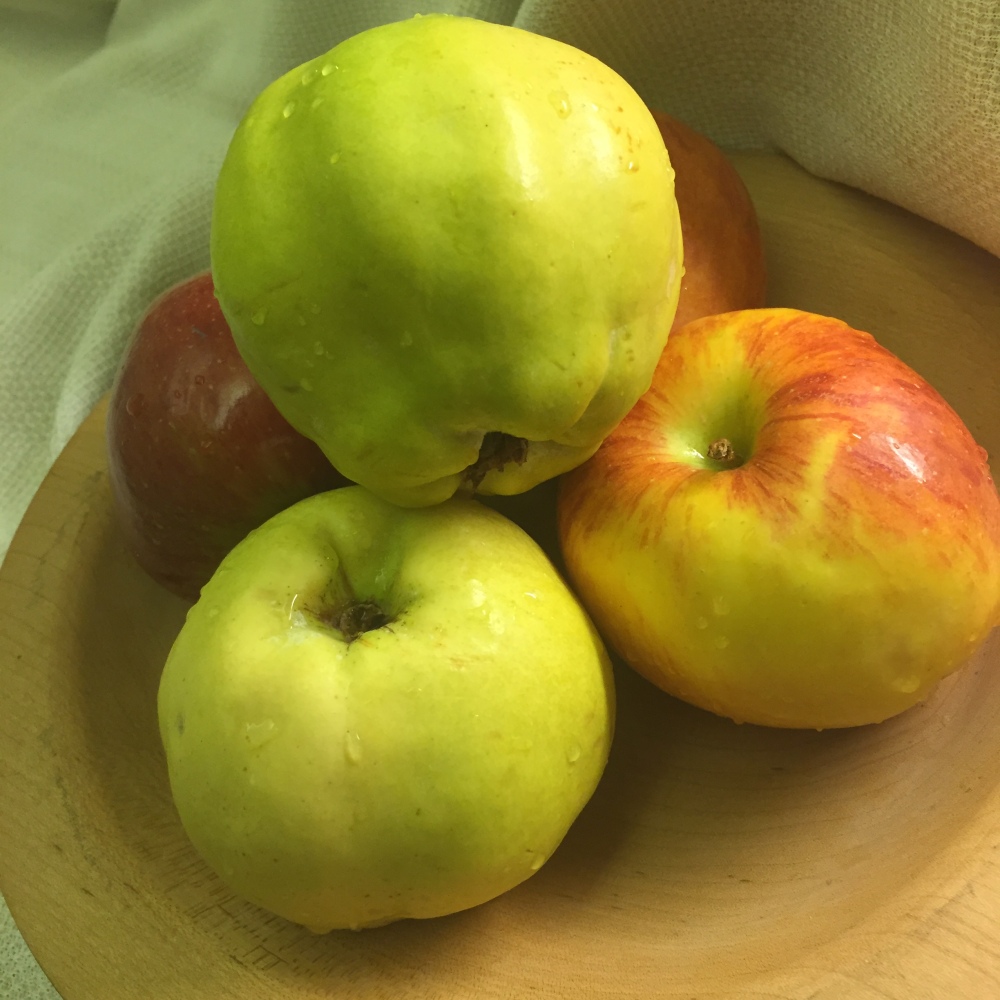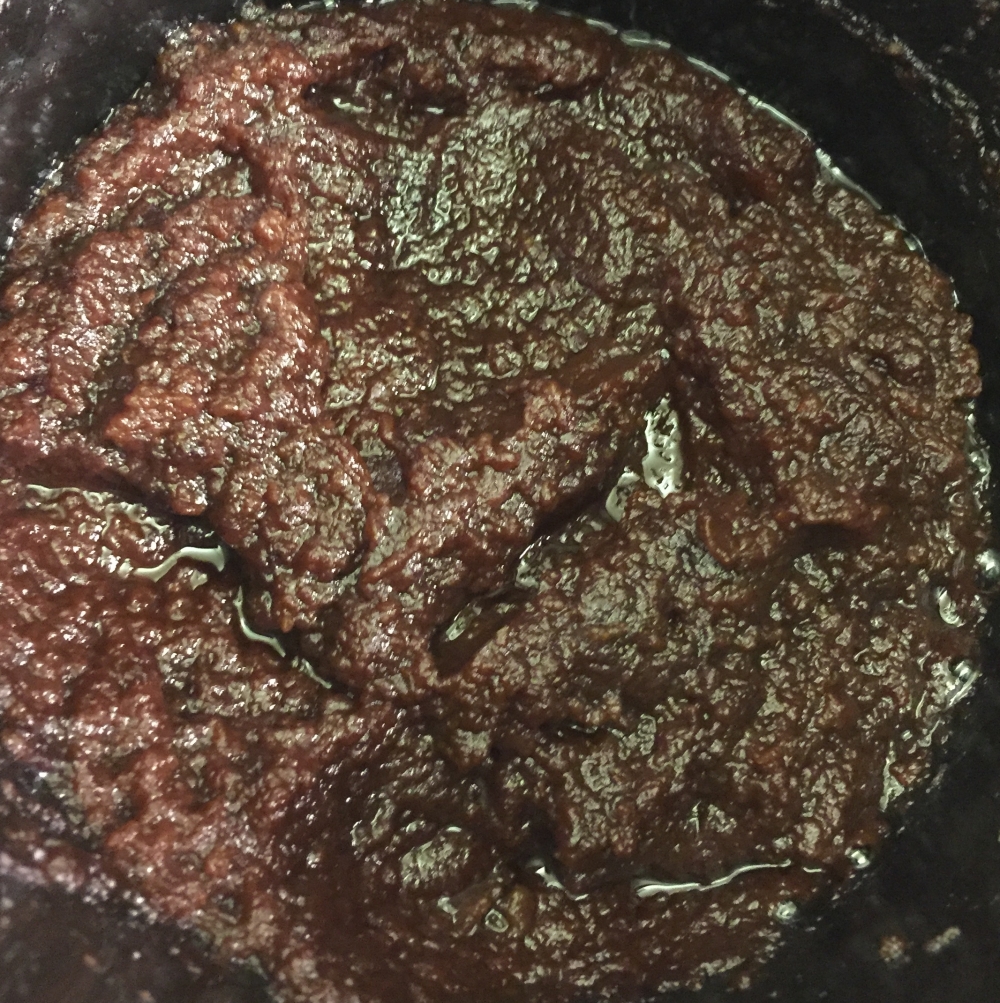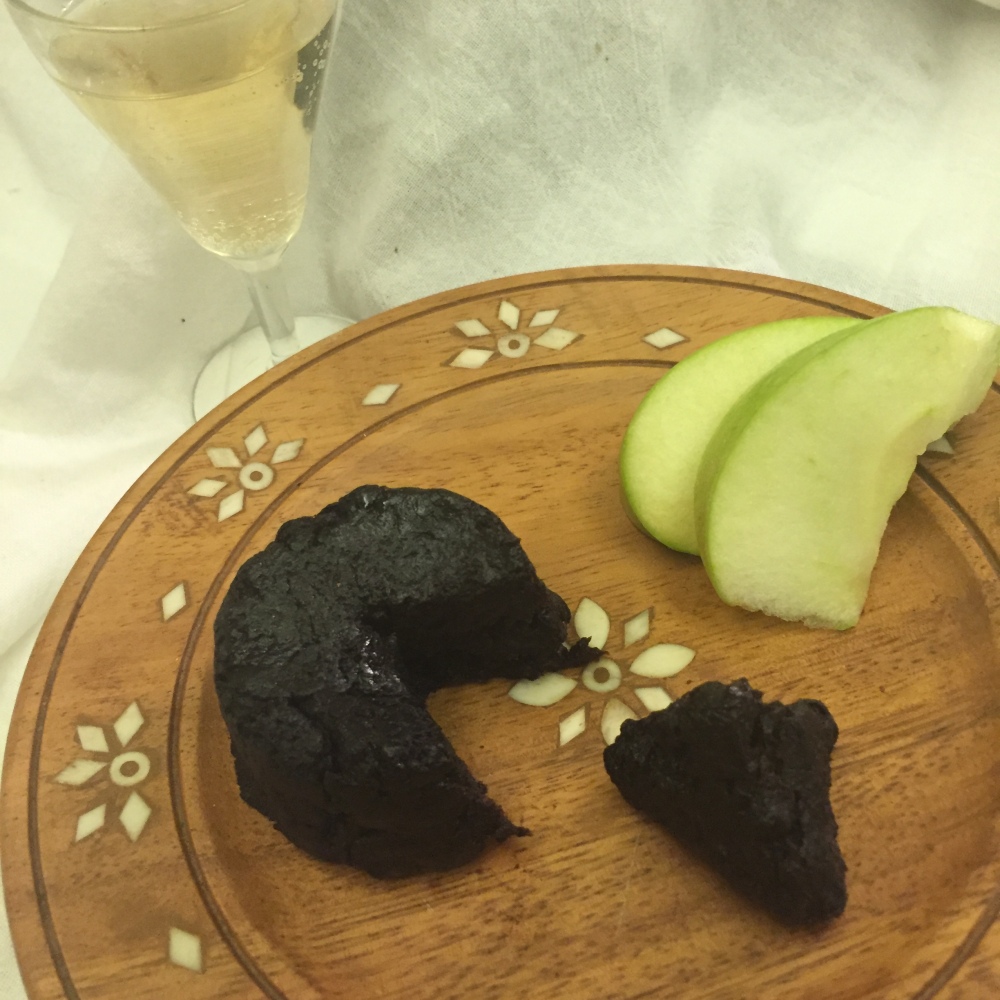Greetings! Finally, we have some autumn crispness in the air, a welcome change after this summer’s heat! The servants have been hauling in bushels of apples and quinces from the orchards and preparing them for winter, either storing them whole in the root cellar or putting them up as preserves. One way to capture their sweet, seasonal flavor is by making Apple Butter (or Latwerge1 in the German) and Quince Paste, both recipes for thickened concentrations of fruit.
 The yellow fruits in the front are quinces, the rest are apples.
The yellow fruits in the front are quinces, the rest are apples.
Latwerge was a thickened fruit preserve that was originally used as a medium to deliver medicine (the sugar and the fruit also considered to have medicinal qualities) but soon became a term for any sweet fruit paste.2 Marx Rumpolt in his Ein New Kuchboch (1581) has several recipes for these Latwerge or preserves, including this one, for elderberries: Confect 24. Du magst auch wol ein solche Latwerge Machen von Hollunderbeer/ das man kein Gewerz darvnter nimpt/ nur Zucker/ oder one Zucker/sonderlich wenn man es brauchen wil zur Artzeney.
24. You also well one such preserve make from elderberry/ that one takes no spices with/ only sugar/ or without sugar/ especially if one will need it for medicine.3
Meanwhile, the Menagier de Paris has a recipe for Quince Paste: 313. Pour Faire condoignac. Prenez les coings et les pelez. Puis fendez par quartiers et ostez l’ueil et les pepins. Puis cuisier en bon vin rouge et puis soient coulez parmi une estamine. Puis prenez du miel et le faictes longuement boulir et escumer, et apres mectez vos coings dedens et remuez tresbien, et le faictes tant boulir que le miel se reviengne a moins la moictie. Puis gectez dedens pouldre d’ypocras et remuez tant qu’il soit tout froit. Puis tailliez par morceaulx et les gardez.
TO MAKE QUINCE PASTE, take quinces and peel them. Then cut in quarters and take out the eye and the seeds. Then cook in good red wine and then they are pressed through cheesecloth. Then take honey and make boil for a long time and skim it, then put in your quinces and stir well and make as to boil the honey until it is about halved. Then add powder of hypocras and stir until cold. Then cut into pieces and keep them.
Quinces were popular in period recipes and, though almost inedible when raw, cook into a rich, sweet red pulp. They look like a cross between an apple and a pear so, if you do not happen to have access to quinces, apples can make a perfectly acceptable substitute.
Peel, core and slice the quinces, apples or combination of the two, place in red wine or water and cook until soft. Once they are thoroughly mushy, press through a wire strainer, a food mill or cheesecloth, as in the Menagier. Return the pulp to your pan.
 Quince pulp. Note the reddish coloring even though this batch was made with water instead of wine.
Quince pulp. Note the reddish coloring even though this batch was made with water instead of wine.
Now, at this point, if you want a sugar- and spice-free latwerge, you can continue to cook down the pulp, thickening it into a thick, soft paste. Spoon into a jar or lidded container, allow to cool and store in the refrigerator. If you want a sweeter latwerge or paste, press onward!
While Le Menagier did not specify precisely how much honey to add to your paste, similar recipes4 specify a weight equivalent to your fruit pulp, so weigh the resulting pulp and add an equivalent weight in honey (or in sugar as both were used in period recipes). As modern honey and sugars are already clarified, you do not have to skim yours.
Add your hypocras spices. As these spice blends varied according to taste and region, you can add period spices to taste (for example, in this version I used cardamom and cinnamon). Use a light hand – the cooking heat will make spices bloom and the further reduction of the pulp will concentrate the flavor, so start light and adjust for taste later.
Keep cooking the mix until it reduces and is thick like jam. At this point you have a sugared latwerge and can put into jars as above.
To make a paste thick enough to be cut, as Le Menagier notes, you need to reduce it even further. Cook the sweetened pulp until it is very thick and begins to pull away from the side of the pan while stirring (being very careful not to let it stick or burn). Turn the paste out into a parchment-lined pan and set it in a dehydrator or in a warm (170*) oven, for approximately 3 hours or so. You are looking for the consistency of a thick paste that can be sliced or molded easily, without being too sticky. My batch was dried flat then pressed into a small jar for serving.
Fruit paste was served on its own as a confection. It could be dried in molds to make figures or modeled into individual sweetmeats like sugar paste. I recommend serving it with a nice sharp cheese as an modern appetizer.
Latwerge (Apple Butter) and Quince Paste
2 lbs of Quinces (or Apples) peeled and cored
2 cups Red Wine or water
20 oz (or so) Sugar
1 teaspoon cinnamon (if desired)
1/2 teaspoon cardamom (if desired)
1. Put fruit in a pot and add wine or water. Boil until fruit presses easily under little pressure and alcohol (if used) is cooked off.
2. Put fruit through a fine-mesh sieve or food mill. Return to pan. If you wish a sugar-free latwerge, continue to cook until pulp is reduced to a thick paste. Season if desired and put into jars, allow to cool and refrigerate.
3. Weigh pulp and add an equivalent weight of sugar to the pulp (mine was about 20 oz). Season, if desired. Cook pulp until it is thick and covers the back of a spoon. If making latwerge, store as above.
4. Place the pulp in a lightly-oiled or parchment-lined pan and place in an warm oven (170*) and let it dry for about three hours until thick, not very sticky, and easily cut. Oven temperature and weather will impact cooking time. Once cooled, store in an airtight container in refrigerator.
 Remember all that fruit from the first image? This is just about all you get out of the process (but it’s so good)
Remember all that fruit from the first image? This is just about all you get out of the process (but it’s so good)
Enjoy! Go forth and cook good food!
Do you have a cookery question you’d like to have answered? Email Lady Alicia at ofnoimp@yahoo.com. Do you happen to know a good French tutor? Mine is hiding in shame at that translation!
1Lea, Elizabeth. A Quaker Woman’s Cookbook. University of Pennsylvania Press, Philadelphia, PA
4 See Quince Paste in Elinor Fettiplace’s Receipt Book, 1604